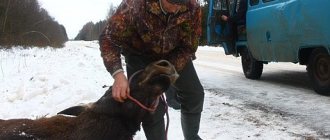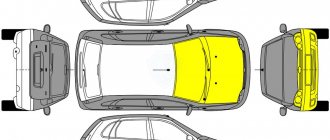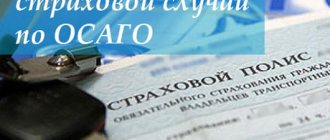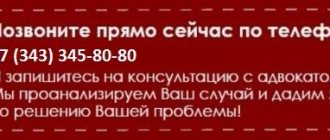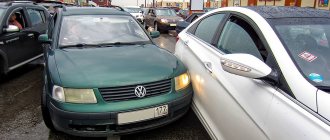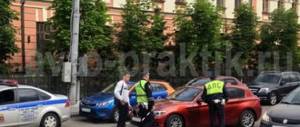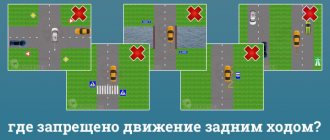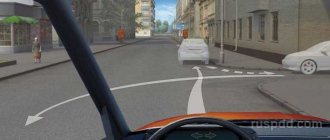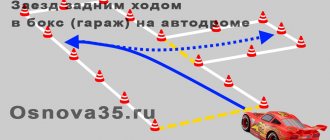What to do first in such an accident?
As with any other accident, the driver should first of all comply with the requirements of the Road Traffic Rules, namely paragraphs 2.5-2.6.1.
Including:
- stop reversing and stop (do not move the vehicle),
- turn on the emergency lights and put up a sign,
- do not move car fragments or any other objects,
- If a car is obstructing the passage, then clear the passage, having first recorded everything in a photo/video.
Don't forget about witnesses to the accident. It’s better to look for them right away on the spot before they go about their business.
And, of course, it is necessary to register the accident itself, if the damage was caused only to vehicles, there were no more than two of them, the drivers are insured for liability under compulsory motor liability insurance, everything is clear to everyone and they agree with all the circumstances - then the European protocol. But we must take into account the limits of the European protocol. If the damage is large, then it is better to register it through the traffic police officers.
How to eliminate the possibility of an accident
Every driver must understand that all maneuvers performed in reverse on a vehicle and leading to a violation are fraught with deprivation of the right to drive a car, but if the consequences are severe. That is why you should carefully study the Rules for maneuvering in transport and follow them when driving.
It would be a good idea to familiarize yourself with the advice of experts and put them into practice:
- If you notice in the rearview mirror a vehicle heading towards your car while moving backwards, postpone performing the same maneuver. Be sure to use a warning signal if necessary. If a sensible driver is behind the wheel, he will understand that he should stop and check the situation. If this method does not give the expected results, then try driving a little forward to avoid a collision. If you make a mistake and drive your car into oncoming traffic in a hurry, you will find yourself equally guilty as the second driver. You will also have to answer equally. If all the actions were performed correctly, but the accident could not be ruled out, attract the attention of passers-by - their testimony will later help in drawing up a correct picture of what happened. This is how you can prove that you are right,
- The second driver in this situation should act as follows - if, while backing up, he heard a vehicle signal, he should immediately brake. The maneuver stops. Get out of the car, if possible, and assess the current situation. Make sure you can continue the maneuver. Compliance with this rule will cost less than paying a fine, plus lost time waiting for traffic police representatives,
- In no case should you neglect the rear view mirror - this is the first assistant in any such maneuvers,
- Separately, you need to pay attention to the situation when leaving limited areas (parking lots, parking lots). You need to monitor the situation not only behind the car, but also on the sides of it. This advice will be especially useful if the driver decides to let a neighboring car exit. You can't get by with just mirrors here.
- if there is no rush, then when you approach the parking lot, perform the maneuver immediately - place your car with the front part facing the exit. Then there will be no problems with leaving. Even if the parking lot later becomes crowded and it becomes difficult to assess the situation, this arrangement of transport will not make it difficult to leave, and you will arrive home on time.
Watch the video. Reversing on a one-way road:
What are the consequences of an accident when driving backwards?
As a rule, responsibility for the violation itself is much less than the damage caused, and the driver who is guilty of an accident may simply “not notice” the fine, if there is one. But who is usually at fault and will there be even the smallest fine or not?
Who is usually to blame?
Paragraph 8.12 of the traffic rules is written in such a way that the one who was moving in reverse, as a rule, is to blame for the traffic accident. After all, driving backwards is allowed only if it is safe and does not interfere with others.
In most cases, traffic police inspectors charge a violation of 8.12 to the person who performed this maneuver. But in the judicial practice of 2021 there are enough such cases that have been successfully challenged.
What's the fine?
To get a fine for driving a car backwards, you need to try harder, so to speak.
- The fact is that in the general case there is no fine or punishment for such a maneuver - there is simply no sanction for this violation in the current Code of Administrative Offenses of the Russian Federation, and the driver does not face anything.
- But in order for the driver to be issued a decree, he must drive in reverse in a place where such a maneuver is prohibited. In this case, he faces liability under Part 2 of Article 12.14 of the Code of Administrative Offenses of the Russian Federation in the form of a fine of 500 rubles.
- No, well, you can, of course, violate 2,500 rubles, but to do this you need to drive in reverse on the highway. Then they will be charged under another article of the Code of Administrative Offenses, namely under Part 3 of Article 12.11.
Who is to blame if a ruling was issued rather than a decree with a fine?
If the driver is not subject to a fine for driving backwards, then the traffic police officer will issue a ruling against him to refuse to initiate an administrative violation case. But a fine is one thing, and guilt in an accident is another thing.
Here it is worth mentioning, shocking for many, the information that traffic police officers do not establish guilt in an accident at all, they only point out the violation of traffic rules by some of the drivers and hold them accountable for this, if it is due. For example, the insurer, and, of course, the court can determine who is at fault for the accident.
Therefore, if you have a copy of the ruling in your hands regarding the driver who reversed into you, you don’t have to worry too much.
Collision between two cars moving in reverse. Who will be to blame?
Quite often in parking lots, for example at large supermarkets, situations occur when, having loaded your car with purchases and seated all the passengers, you hear a dull thud when reversing.
There is a collision between two cars that were reversing at the same time. Who will be to blame, according to current legislation?
Getting into a similar situation is easy for car owners who live in large cities. This can be not only the parking lot of a shopping center, but also an airport, restaurant or other places with large crowds of people. Therefore, the question of whose fault it was if both were moving in reverse remains open.
Who was the first? After the traffic police arrived at the scene of the emergency, they studied the available materials from the car’s video recorders, after which a decision was made about driver A’s guilt, since driver B started driving his car much earlier. This is confirmed by available video recordings. Before releasing the brake pedal, the person responsible for the accident had to make sure both that the maneuver could be performed safely and that his actions would not interfere with other vehicles if they were present near his car. If there is video recording, there should not be any special problems in identifying the culprit.
Hit by another car. Another variant of the situation may be that while reversing, the driver made a stop in order, for example, to calm a crying child. At that moment, another car, also reversing from another lane, crashed into his car. If there is evidence that the first vehicle was stationary at that time, the second driver will be found guilty.
The presence of left and right. According to one of the car owners, such a situation occurred in his driving practice. After the collision, the traffic police officers who arrived at the scene determined that the car that was on the left was at fault, according to the “interference on the right” rule. After the case was handed over to the review team, the inspectors were accused of incompetence, and the case materials were called “blatant nonsense.” Drivers should remember that in this situation, the left or right position of vehicles does not matter at all.
Mutual guilt. In that rare case, when it is not possible to identify the culprit, that is, both cars moved to places at the same time, no one made a stop, and there are no witnesses and recordings from video recorders - the drivers of both vehicles who became participants in the accident will be found guilty situations. In this case, both participants in the accident will be issued a protocol, the basis for which is clause 8.12 of the Traffic Regulations, which states that “reversing is permitted only if the driver is confident in the safety of this maneuver and the absence of obstacles for other cars.”
If we take into account compensation for damage under compulsory motor liability insurance, then in this case both drivers can only count on payment in the amount of 50% of the possible amount of compensation. But if they disagree with the decision made, the participants have the opportunity to resolve the issue in court. As a result, the decision may be revised and a different amount of compensation established.
Bottom line. Before starting to reverse, anywhere, the driver must make sure that it will be safe and that his actions will not create problems for other road users maneuvering or moving nearby.
Overview of parking situations
I would call parking at home or at some shopping center a place of increased danger from the point of view of emergency situations. Cases when one car is parked and another crashes into it in reverse usually happen in parking lots and parking lots.
Backed into a parked car in a parking lot
In general, this situation will be the simplest: for both the culprit and the victim. Here the speeds are low and the damage is low, so very often everything ends in a European protocol, in which the driver who was moving backwards admits his guilt.
If not, then the inspectors will make a decision about refusal, but the “reverse” will still be to blame for the accident.
Crashed into a pole, fence or other objects
You can enter a pole, fence, gate or other means of organizing traffic in a parking lot in two ways:
- without violating any rules except 8.12,
- violating something else - for example, marking parking spaces.
In the first case, there will be no liability for this violation; there will be a decision to refuse to initiate a case regarding the APN.
Secondly, you will also have to pay a fine if the inspector acts in strict accordance with the law and issues a document under Part 2 of Article 12.14 of the Administrative Code.
In any case, these are all little things. The unfortunate driver ends up having to repair his car, and maybe also pay compensation for damage to the owner of the pole. Wanting to avoid all this, some people simply drive away from the scene of the collision, but I would not recommend doing so, since you can lose your driver's license for leaving the scene of an accident.
If both cars were given back, is it mutual fault?
As mentioned earlier, the key tasks when driving backwards are to ensure traffic safety and not interfere with other road users. If both drivers had to monitor the fulfillment of these conditions, then both will be at fault in the event of a collision.
But the answer, “yes,” will not be clear. There are cases when both backed up, but one noticed the danger in time and stopped, and the second continued moving. In this case, the driver who continued driving will be to blame, but only if there is indisputable evidence of this, the most important of which is the DVR.
Although, there are cases when, even without such undeniable evidence, one person can be blamed. In a civil case regarding compensation for damages in an accident, they found out who violated what and who was to blame. Or rather, the court of first instance did not particularly find out who was to blame, but decided that the guilt in the accident had already been established, and the Moscow City Court did not change anything and recognized the decision as legal.
In fact, in this example, both drivers were moving in reverse, as stated in the appeal, but only one was found responsible for the damage.
The culprit's car rolled back and crashed into your car.
The movement of the vehicle backwards in itself is not a violation of paragraph 8.12 of the traffic rules. Moreover, in the situation under consideration, the driver is not behind the wheel. But the fact that he is not in control will not relieve him of responsibility.
True, this responsibility will be under a completely different article of the Code of Administrative Offenses, namely under Article 12.19, for violating the rules of stopping or parking.
Fine for an accident in a parking lot
Accident in the parking lot. The driver left the scene of the accident.
Drivers usually feel more relaxed when leaving a parking lot than when driving on the road. But such behavior is fraught with not very pleasant consequences.
Simple inattention and distraction can lead to damage to another parked car. Often this situation occurs at the moment when the driver backs up.
The first desire that most motorists have is to quickly leave the scene of the accident in the hope that no one noticed the accident.
But such an action can only harm you, because punishment is also provided for offenses of this kind. It's good if you only get away with a fine. But if you run away, the punishment will be more serious. And you probably don’t want to lose your driver’s license.
Then call the traffic police yourself, wait for them and the owner of the damaged car. And then file the incident in accordance with the requirements of the law. This will cost you a fine.
Otherwise, by a court decision, you will be deprived of your right to drive a car. This is the most common court decision in such situations.
For leaving the scene of an accident, the driver will be deprived of his driver's license.
Administrative liability (fine) for an accident in a parking lot.
Typically, drivers leaving a parking lot create an emergency situation or get into one when reversing.
But such movement, according to traffic rules, is possible only in certain situations:
- When reversing will not interfere with other road users or the situation is completely safe;
- If there is someone to turn to for help (direct the driver’s movements) in case of poor visibility.
Under no circumstances should you drive in reverse:
- Being at a crossroads;
- In places where it is prohibited to turn around: pedestrian intersections, tunnels, bridges, overpasses, railway crossings, public transport stops, etc. U-turns on the road are also prohibited if visibility within a radius of 100 meters is very poor.
For violation of traffic rules, which are responsible for the rules of maneuvering on the roads, administrative liability is provided for violating drivers (Article 12.24 of the Code of Administrative Offenses of the Russian Federation).
Thus, when a traffic accident occurs in a parking lot while one of the cars is moving in reverse, the driver of that particular car will be found guilty (in 90% of cases).
When an accident occurs in a parking lot, just like any other accident, the incident must be documented in accordance with the requirements of the law. That is, after the accident is registered, the culprit must have an official document.
In the event that you, while driving a car, damage someone else's car in the parking lot, never run away. Wait for the owner of the damaged car and register the incident.
If your car was damaged in the parking lot, do everything to collect as much information as possible about the car that caused damage to your vehicle, find eyewitnesses, etc.
Each specific parking incident has its own characteristics. Therefore, to better understand your actions and possible consequences, contact a lawyer.
Based on analyzes of documents, eyewitness testimony and other materials, experts will tell you how to proceed. Sometimes an experienced look at the essence of the incident is enough, and the whole situation can radically change.
Imposition of a fine
If the culprit of an accident in a parking lot leaves the scene of the accident without a valid reason, he will have to pay a fine.
You must understand that today you cannot simply avoid punishment. Sometimes drivers hope that no one noticed their actions. But do not forget that all modern car parks and parking lots are equipped with CCTV cameras.
Therefore, there are no particular difficulties in finding offenders in parking lots now.
Let's look at what administrative liability and punishment are provided for in Art. 12.27 of the Code of Administrative Offenses of the Russian Federation for leaving the scene of an accident in a parking lot:
| Warning | If the driver violated his license for the first time |
| Administrative arrest | Up to 15 days |
| Money penalty | From 500 to 1500 rubles |
| Revocation of driver's license | From 1 year to 1.5 years |
| Vehicle arrest | Until the fine is paid; For up to 15 days. |
Experts, interested in this problem, decided to evaluate the situation with the occurrence of accidents that occur in the parking lot. They took the period from June 2021 to May 2021 for their assessment.
The results were quite unexpected. During the studied period, of the total number of vehicle accidents, parking accidents accounted for 40%.
The data obtained speak for themselves. This issue should be thoroughly studied by the relevant authorities. The main thing is to find ways to resolve the problem situation.
If previously traffic police and police officers paid more attention to traffic safety on the road, now their attention is increasingly attracted to the situation in parking lots.
Road accident
There are no less situations when you have to drive back on the road than in parking lots. After all, you can park on the road, but in this situation the cars around you are usually moving. You can also drive through your own turn, exit or intersection. Let's look at the situations in more detail!
We were driving backwards and crashed into a moving car.
The situation is simple, but the speed of its resolution will depend on the behavior of the participants in the accident. Someone will do the right thing and immediately admit guilt, someone can ruin the life of the victim until the very end with their inventions. But one way or another, the one who gave it back must be identified as guilty. Whether this will be true in your situation is impossible to say; traffic police inspectors are different everywhere and with varying degrees of impartiality, let’s say.
But it would seem that, despite the simplicity of the situation, events may develop a little differently, as, for example, in this case. In short, the driver who was simply rear-ended could not prove that he was not reversing.
Usually the situation is the other way around: somewhere on a hill, the driver of a car that rolled back claims that he was caught from behind.
Important note!
- This article describes the basic principles of how legislation works. Meanwhile, in judicial practice everything depends on specific circumstances.
- In 96% of all cases there are subtleties that can affect the outcome of the entire case.
- Therefore, we recommend entrusting the matter to professionals who will study your business and select the right winning strategy.
The TonkostiDTP website employs professional road accident lawyers with experience in all major types of disputes (MTPL, guilt, administrative penalties).
Ask a lawyer
or get a free consultation by calling the hotline: 8.
Reversing at an intersection
This situation will differ from those previously described in that here the violator will no longer be left without a decision. It will be issued under Part 2 of Article 12.14 of the Administrative Code, since reversing at the intersection is prohibited. It makes no difference whether it is a controlled or unregulated intersection.
Here, for example, is the Decision of the Khoroshevsky Court of Moscow in case No. 12-731/16, in which one motorist was punished for driving in reverse. Despite the fact that “the matter is dark”, since one says one thing, the other says another, this decision stood in a higher court and was not overturned.
Let us remind you that according to the traffic rules:
An intersection is a place where roads intersect, join or branch at the same level, bounded by imaginary lines connecting the opposite, most distant from the center, beginnings of curvatures of roadways. Exits from adjacent territories are not considered intersections.
I was leaving the surrounding area and collided with someone who was turning back on the road
Knowing the definition of an intersection and being able to identify it on the ground is very useful. After all, it’s one thing when you’re driving in reverse at an intersection, and another thing when you’re just driving along the road. We can say that the fault in the accident will depend on this.
The following situations are possible:
- one car is driving backwards along the road, passes through an intersection where a second car exits,
- car No. 1 moves back along the road, and car No. 2 leaves the adjacent territory.
It would seem that there are two situations and there may also be two options for guilt in these accidents, but in reality everything is not so simple. In addition to the two obvious decisions about who will be to blame, judicial practice in 2021 may present us with a third option, when the one who is reversing on the road is to blame for an accident with someone leaving the adjacent territory.
A similar case was heard in the Moscow City Court in case No. 7-11166/2018. But the matter is ambiguous, since we know that the second participant left the adjacent territory only from the words of the person involved, and he should not always be trusted.
But the court can also treat the case quite formally, without finding out what actually happened, the intersection or the adjacent territory at the scene of the accident. For example, in case No. 4A-0471/2019, only the Moscow City Court, when considering a complaint against the decision, asked the question of what the traffic situation actually was. In the case under consideration there was even a 2.1 “Main Road” sign, which was later dismantled. But in the end, the one who left the adjacent territory was found guilty.
But there is more standard practice for such situations, here are a couple of examples:
- Decision of the Moscow City Court in case No. 7-14727/2019
- Decision of the Moscow City Court in case No. 7-8919/2019
Sometimes the Supreme Court is forced to find out where the second participant in the accident was moving, along the road or adjacent territory. All courts up to the Supreme Court upheld the decision against the driver under Part 3 of Article 12.14 of the Administrative Code, indicating that he was leaving the adjacent territory. The Supreme Commander canceled everything and dropped the case. It turns out that the accident took place at an intersection, and the second participant was reversing at it.
On a one way road
In 2021, the courts are already fully applying the explanations of the Plenum of the Supreme Court of the Russian Federation No. 20 of June 25, 2021, which indicate how and under what article it is necessary to attract drivers.
Thus, paragraph 16 of the Plenum states that reversing on a one-way road is not prohibited in itself. Therefore, if the driver does not violate anything else, then he should give way if, for example, you leave the adjacent territory.
But if an accident occurs when a driver is reversing and driving through a “No Entry” sign, and even if at an intersection, then the person responsible for the accident will be clearly identified. And they will attract him under several articles at once, under Part 3 of Article 12.16 of the Code of Administrative Offenses and Part 2 of Article 12.14 of the Code of Administrative Offenses.
On the motorway
Here, reversing is expressly prohibited by the Rules, but there may be situations where the blame is shared between two drivers.
On highways, not only the speeds are high, but also the distances. And here it is important whether the second driver, with due attention and caution, could have noticed the danger and prevented the accident. For example, on a straight section of the highway, one car will slowly drive in reverse, and the second will simply drive forward. When the road is relatively empty, the second driver should notice that the distance between the cars is rapidly decreasing, which means that they need to take care of the appropriate distance or change lanes. If this is not done, and the expert identifies this possibility, then the blame for the accident will most likely be shared.
Registration of an accident in a parking lot
When two cars collide in a parking lot, you can file an accident in several ways:
- drawing up a European protocol without calling law enforcement officers;
- calling the traffic police.
If an accident is registered with the help of a traffic police representative, the following actions are necessary:
- perform video shooting, take photographs;
- make way for other cars.
Traffic police representatives perform the following actions:
- draw up a map of the scene of the incident;
- inspect the vehicle and record damage;
- find out who caused the accident;
- conduct interviews with eyewitnesses and review video recordings from surveillance cameras;
- draw up a protocol.
At the end of the procedure for registering an accident, the inspector gives copies of the protocol to the participants in the accident. Having a report, the victim of an accident submits an application and other documents to the insurance company to receive compensation for damage.
For the culprit of the accident, the protocol has a not very pleasant meaning, since it is proof of his guilt.
If there is a Europrotocol, the victim can also apply to the insurance company for compensation for damage, since according to the law, the Europrotocol is equal to the standard protocol.
If there are two cars involved in an accident, there is no talk of insurance payments in the form of direct compensation.
What happens if you hit a car in a parking lot and drive away?
Read here what to do if you scratched your car in the yard and fled.
What happens if you leave the scene of an accident without realizing that it was an accident, read the link:
The Europrotocol is a document that is drawn up by drivers independently. But there cannot be more than two participants in the accident, and they must have a common view of the incident.
In addition, car owners must have MTPL insurance policies that have not expired at the time of the accident.
Actions of participants in an accident when registering a Europrotocol:
- take photographs and videotape;
- find eyewitnesses of the incident;
- draw up a diagram of the accident and include it in the notification form (with the consent of the parties);
- document damage to the vehicle;
- determine the culprit of the accident;
- sign the document;
- clear the road for other vehicles.
A diagram of the accident site is drawn up in any case. When drawing up the Europrotocol, it must have the following content:
- The location of the accident in the parking lot is indicated. To do this, draw a separate part of the parking lot. Cars that are located near this location are also included in the diagram;
- Record the location of the vehicles involved in the accident;
- The direction in which the vehicle was moving is recorded. It is imperative to clarify which of the cars was moving and which was just standing;
- Markings, directional signs, pillars, flower beds, etc. are sketched;
- If the accident occurred in the parking lot of an organization, its name should be indicated, as well as the names of neighboring streets, buildings, etc.
If there is such a need, additions can be made to the diagram (for example, indicate the point of contact of the vehicle).
Be sure to notify your insurance company about the accident and the occurrence of an insured event.
If you called the traffic police to the scene of the accident, they themselves will create a diagram of the accident.
When the traffic police inspector draws up the diagram, stay close to him and, if the need arises, ask him to make adjustments.
An important subtlety about an offender who does not have an advantage
The fact that one should not give way to someone who moves in violation of the rules was initially indicated only in specific cases that reached the Supreme Court. Now, in 2021, such an explanation is included in the above-mentioned Resolution of the Plenum.
In the situations we described, this approach is also used, for example, when someone backs up at an intersection, and accordingly violates traffic rules, and in this case there can be no talk of any priority.
To justify this to the court, you can follow this sequence instruction:
- it is necessary to indicate which points of the Rules should have been followed by each driver,
- quote these paragraphs of the traffic rules, as well as definitions of what an intersection is, what an adjacent territory is, what it means to give way,
- it is necessary to emphasize that only those traffic participants who have priority in traffic need to give way (not create interference),
- point out that the driver who violates traffic rules is deprived of this very priority, and there is no obligation to yield to him.
When is the one behind not to blame?
So, let's start with the fact that only the court is authorized to establish guilt in an accident. Traffic police inspectors only identify a violation of one of the participants in the accident or both and issue orders with a fine or a protocol with deprivation or other sanction.
When deciding on guilt, courts consider road accidents from the point of view of the cause-and-effect relationship (CAL), which is especially important when there is mutual guilt and establishing the degree of guilt for each of the participants. So, it may be useful to answer the following questions:
- whose violation led more to the accident,
- whose absence of traffic violation would not lead to an accident more likely?
Typically, the answers to these questions provide a clear indication of the degree of culpability. We will also consider situations with accidents with a car rear-ended, taking into account the PSS of guilt.
If the front one moved backwards
And we'll start with the most obvious! Of course, if the rear car was parked and a car driving in front of it in reverse drove into it, then the one who was driving is to blame.
The cause-and-effect relationship here is seen in the fact that the person standing cannot possibly be guilty, even if he stood in violation of traffic rules. Why? Everything is very simple. If instead of a car there was a pedestrian, even a tree, would it help to avoid an accident or not? Of course, if a person moving in reverse claims that he did not notice the parked car, then he would not have noticed the tree.
Therefore, the “front” one is to blame. But the violation here is not of paragraph 10.1, of course, but of 8.12, which instructs the driver to move backwards only if this maneuver is safe. There is no fine for violating this clause, but there is more than enough civil liability!
But if the rear car did not stand still, but moved forward, then the matter will already be considered in dynamics - all other things being equal, there is a high probability of mutual guilt.
If the person who drove into the rear was first hit from behind
Now consider an even more complex situation: a 3-car accident:
- the first one slowed down because he needed to turn soon,
- the second began to brake sharply to avoid a collision,
- the third, without keeping a distance, drove into the back of the second,
- As a result, the second one was thrown forward, and he drove into the hall of the first one.
As in the diagram:
There is one accident here, and in this case the guilt of the third is obvious, since if he had not hit the second, then the accident with the first would not have happened. That is, the second one kept a safe distance and drove the car according to the Rules, since he managed to brake in front of the first one, and the impact on him occurred precisely because of the third person hitting the second car.
That is, here the second one, even though he drove into the back of the first (black) car, all the blame for the accident lies with the latter, since all the impacts occurred through his fault.
If the driver was hit in the ass later
Let's complicate the task even more:
- the first car slows down,
- the second, due to failure to maintain distance, almost at full speed drives into the rear of the first,
- the third hits the second, who suddenly stopped due to the blow.
The picture of the accident diagram is the same here:
So, the guilt of the second car, which crashed into the rear of the first, is obvious. He violated paragraph 9.10 of the traffic rules by not keeping a distance.
But the guilt of the third is not so obvious! Paragraph 9.10 talks about the distance to the person moving ahead, but the second person was standing at the time of the accident. Clause 10.1 of the Rules states that the driver must have time to stop only when he can detect a danger that has appeared. But the driver of the third car might not have seen (was not obliged to see) that the second one was not keeping his distance and was driving the car at such a speed as to stop if the second one started to brake urgently. But the second one braked against the first car - that is, it stopped, one might say, with a stake. Therefore, the guilt of the third is not obvious.
Of course, this is a very complex example, and there are quite a lot of other subtleties that force us to consider each such accident individually and in dynamics. So, the guilt of the third is influenced by the following factors:
- how much time generally passed between two blows: the second on the first and the third on the second; it is likely that the driver of the third could detect the danger, but did not keep his distance; if so, then the traffic police may recognize this as two separate traffic accidents, and not one;
- the speed of all participants in this accident, but especially the third one; we are talking not only about the excess, but also about its dependence on weather and road conditions;
- explanations of the participants - if, for example, the driver of the third car writes that he was looking at his phone, this will significantly increase his chances of becoming guilty;
- the presence of video recorders in each car - the second can say that he drove into the rear of the first after it was hit by the third participant, and it will not be easy to prove the opposite; in the absence of evidence, mutual guilt is possible (although a trace analysis can determine the causes and consequences of the impacts).
If they admitted mutual guilt - will I receive 50% of the payment?
If, in the opinion of the inspectors, both drivers violated the rules when reversing, then both are considered violators. In this case, everyone will receive 50% of their damage.
It’s another matter when in reality one of the drivers did not violate anything, but the inspectors did not want to look into it or for some other reason issued a decision. You can appeal the decision through the admin panel, but if it doesn’t work out, then you shouldn’t give up.
As mentioned above, the inspector’s decision is not an establishment of guilt in an accident. It says that Uncle Vasya violated such and such a point of the rules, and that’s all!
Fault in an accident can be established in a civil manner as part of a claim for compensation for damages from the accident in full. Accordingly, it must be submitted to both the MTPL insurance company and the culprit.
What if the second participant cheats?
In fact, you need to think about the fact that the second participant will cheat even before you get into an accident. To resist this, you need to know in advance how to resist it. Below I will list some means and ways to protect your rights:
- a video recorder is almost the most reliable and reliable means of protection against fraud in an accident while driving in reverse; you can have one, but the more the better - so that the second lens or camera is filmed back and/or into the car interior,
- recordings from cameras at the scene of an accident - the video from the recorder may be erased, not recorded, the whole picture of what is happening may not be visible on it, then recordings from external cameras will help out,
- witnesses - they can see the whole picture of the incident from beginning to end, but still are not an unconditional guarantee of establishing the truth, since the courts do not always believe their testimony,
- photographs of the accident scene and damage,
- examination is a common method, but not always reliable, because as many experts as there are so many opinions. And the examination will be carried out based on the case materials, and it is very difficult to win a case without the evidence indicated in the first three points.
It is important that all this must be done at once. If possible, immediately at the scene of an accident, you need to look for drivers who have a recorder, look for witnesses, look where there are CCTV cameras, take photographs of the scene of the accident (cars tied to the area and stationary objects, fragments, traces on the road, damage to the car). You must petition inspectors to seize video from external cameras. Evidence that confirms your innocence should be subsequently added to the case file.
What to do if you crash into a parked car
The condition of the second car at the time of the accident will largely determine your further actions. First, it’s worth discussing what rules apply to cars parked in a parking lot and finding out what to do if you crash into a parked car.
The bottom line is that even a collision with a car that is parked in the parking lot is regarded by the traffic police as a traffic accident. Therefore, your actions must be accordingly.
Advice! Whatever your stress from what happened, do not leave the scene of the accident! This will only make the situation worse. The best thing is to take deserved responsibility, and not make the situation worse!
So, what should I do if I was reversing, crashed into a car, and the driver was not there? Here are a few developments.
- The most correct and legal thing is to call a traffic police representative. Of course, you will have to expect it, but leaving the scene of an accident will result in a more serious penalty than just a fine for the accident and damages that will be compensated by the insurance company.
- You can leave a short note about what happened to the owner of the other car, outlining the details of the case. Express your readiness to resolve everything amicably without calling the police.
However, there are pitfalls here: if the second driver has CASCO insurance, he does not have the right not to call the police, otherwise he will not receive insurance. Let’s also consider the simplest thing: the driver comes, sees his iron favorite crumpled, and does not find the note that was carried away by the wind. And he calls the traffic police. It turns out that in this case you become a violator who fled the scene; you most likely do not need such troubles.
Do you need a diagnostic card in case of an accident?
Find out how to help a downed dog here.
What to do if you get into an accident, read the link:
If you do find or wait for the driver of the second car, you should decide with him how you will proceed. If the person you come across is adequate and you can come to an agreement with him, then decide everything yourself. However, after agreements, do not forget to seal the union with a mutual receipt. This will protect against the case if the second driver still wants to call the police in order to also obtain insurance from the company. Otherwise, you can quickly be found for failure to comply with the law on not leaving the scene of an accident.
If peaceful contact does not work out, or the driver has CASCO insurance and the damage is so severe that he wants to get it, call the traffic police. But before they arrive, don't leave this place!
Now the driver knows what to do if he crashes into a parked car. Let's discuss the nuances of behavior if the accident occurred at the moment when you were backing up.
